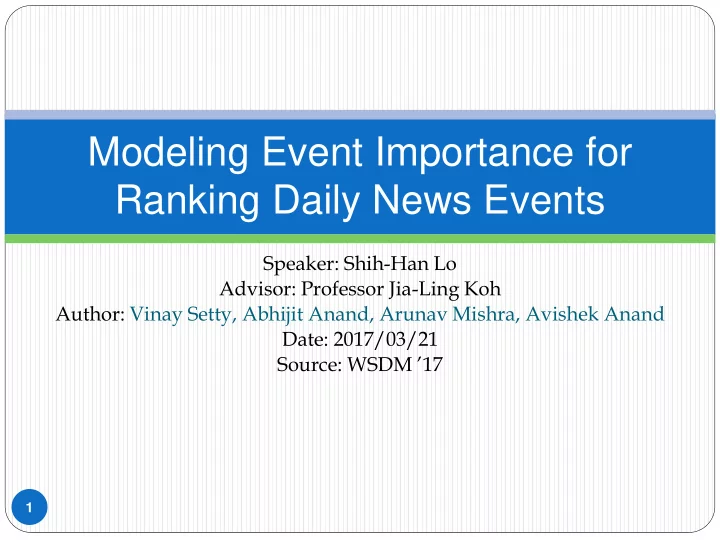

Modeling Event Importance for Ranking Daily News Events Speaker: Shih-Han Lo Advisor: Professor Jia-Ling Koh Author: Vinay Setty, Abhijit Anand, Arunav Mishra, Avishek Anand Date: 2017/03/21 Source: WSDM ’17 1
Outline Introduction Method Experiment Conclusion 2
Introduction Google News Business Insider 3
Introduction Motivation The observation that both automated aggregation and manual curation of news events need to solve two fundamental tasks: Mining news events Modeling news importance 4
Introduction Goal Model the importance of wide variety of news events reported by large number of news articles. 5
Introduction https://en.wikipedia.org/wiki/Portal:Current_events/April_2014 6
Outline Introduction Method Experiment Conclusion 7
Method Problem Definition News story 𝑒 ∈ is a news article document. News event c , a cluster of stories associated with a news event. News topic, σ . We approach the news ranking problem as a Learning-to-Rank task, specifically SVMRank . 8
Method Mining Daily News Events First, we need to mine events from the news collection. A bag of entities ℰ(𝑒) A bag of shingles 𝒯(𝑒) (w-shingling, n-grams) We combine entities and shingles into a single bag ℱ 𝑒 = ℰ 𝑒 ∪ 𝒯(𝑒) . Then: Frequency of unique entities 9
Method Problem: Inability to accurately determine the true number of events We resort to Locally Sensitive Hashing (LSH) with min-wise independent permutations. Cluster cohesiveness: 10
Method Improved Popularity Estimation Improving Cluster Size Estimate Cluster centroid Radius Maximum Sub-Cluster Density k , with ρ k as the radius containing k nearest neighbors of the centroid. Find a sub-cluster which maximizes k / ρ k (= ψ max ). Effective size: 11
Method Source Diversity Collection bias: Relying only on structural features may be misleading. Compute a diversity score for each cluster: Source Authority We extract all possible news citations and construct a probability distribution based on their frequencies. 12
Method Historical Importance Cluster Chaining Previous day similarity: The overall historical value for a chain initiated from c is: 13
Method 14
Method Temporal Profile from Named Events Moving Window Language Model : Moving Window Entity Overlap using the disambiguated entities: 15
Method Temporal Prior: Frequency of edits Finally, we compute historical significance on a day t : 16
Outline Introduction Method Experiment Conclusion 17
Experiment Datasets Gdelt 8 million stories. Sep. 2013 – Aug. 2014 (365 days). 6000 sources from 167 different countries. Stics 1.69 million stories. Jan. 2014 – Jun. 2015 (545 days). 300 sources from 10 different countries. 18
Experiment Benchmark GTS We add the news stories referred in the WCEP summaries into the input collection. Time Lag Within the 3 days window of the WCEP dates. 19
Experiment Ranking Results 20
Outline Introduction Method Experiment Conclusion 21
Conclusion We introduced the problem of ranking a daily batch of events for large heterogeneous news corpora. With the use of improved popularity and historical features for events in a learning to rank framework we came up with an effective daily event ranking. 22
Recommend
More recommend